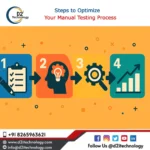- Software Development
- March 15, 2024
- admin
The Definitive Guide to Custom Software Development

In today’s digital era, businesses are constantly seeking innovative solutions to stay competitive and meet evolving customer demands. Custom software development has emerged as a game-changer, offering tailored solutions to address unique business challenges. In this comprehensive guide, we unravel the custom software development process, from initial consultation to deployment and beyond. Follow along as we explore the stages, emphasize the importance of collaboration, and share insights into best practices and methodologies.
Step 1: Understanding the Custom Software Development Process
- Dive into the intricacies of custom software development, explaining its significance in driving business growth.
- Outline the key stages of the development process, including consultation, requirement analysis, design, development, testing, deployment, and maintenance.
- Highlight the benefits of custom software over off-the-shelf solutions, such as scalability, flexibility, and enhanced performance.
Step 2: The Power of Collaboration: Client-Developer Partnership
- Emphasize the importance of collaboration between clients and developers throughout the project lifecycle.
- Discuss how effective communication and active participation from both parties lead to successful outcomes.
- Share tips for fostering a collaborative environment, such as regular meetings, transparent communication channels, and feedback loops.
Step 3: Best Practices and Methodologies in Software Development
- Provide insights into popular software development methodologies, such as Agile, Scrum, and Kanban, and explain how they drive efficiency and flexibility.
- Discuss the importance of continuous testing, code reviews, and quality assurance measures to ensure a robust and reliable software solution.
- Showcase your company’s commitment to adhering to industry best practices and standards, highlighting certifications or accreditations.
Step 4: Leveraging Technology for Success
- Explore the latest technologies and tools used in custom software development, such as cloud computing, AI, machine learning, and DevOps.
- Explain how these technologies empower businesses to innovate, automate processes, and deliver exceptional user experiences.
- Share case studies or success stories showcasing how your company has leveraged technology to solve complex business challenges for clients.
Conclusion
Custom software development is not just about writing code; it’s about understanding business objectives, solving problems, and delivering value. By following the steps outlined in this guide and embracing a collaborative approach, businesses can embark on a successful software development journey that drives growth and success. At D2i Technology, we are passionate about helping businesses thrive through custom software solutions tailored to their unique needs. Contact us today to start your journey towards digital transformation and unlock the full potential of custom software development.
Latest News

Transform Your Business with Top Web Development
June 30, 2025

Steps to Optimize Your Manual Testing Process
June 16, 2025
Category
- Accessibility Services (19)
- Accessibility Testing (6)
- Application Development (5)
- Automation Testing (4)
- CDN Technology (1)
- Developer Tools (5)
- DevOps (28)
- DevOps Consulting Companies (2)
- DevOps Services (2)
- Digital Marketing (5)
- Game Testing (1)
- IT Services (8)
- Manual Testing (6)
- Mobile Development (4)
- Operating Systems (2)
- SecOps (1)
- Security (1)
- Software Development (2)
- Software Quality (2)
- Software Testing Companies (1)
- Testing (1)
- Uncategorized (4)
- Web Application (2)
- Web Designing (3)
- Web Development (6)
- Web Development Companies (6)
- Website Accessibility (16)
- Website Services (3)
- WordPress (2)
